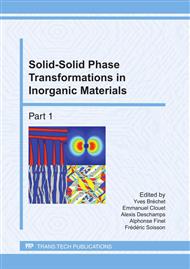p.851
p.857
p.863
p.869
p.875
p.881
p.887
p.893
p.899
Effects of Two-Step Tempering Treatment on the Microstructural Formation of T91 Ferritic Steels
Abstract:
As a representative type of high Cr ferritic heat-resistant steels, T91 steels (ASME SA-213 T91/P91) has been recognized as the preferable materials and widely used in high-temperature structural components such as header and main steam pipe in advanced power plants. For the service condition is tempered martensites, its corresponding microstructure and mechanical performance are mainly adjusted by the tempering treatment. After exploring the size and number of MX and M23C6 precipitating particles and the width of martensitic lath as a function of tempering temperature, it is recognized that the high tempering temperature leads to an increase of secondary hardening effect, while the low tempering temperature brings a high dislocation density and a small martensitic lath. Hence, a two-step tempering treatment was developed after the traditional normalizing process, in which the T91 steels sample was firstly tempered at a low temperature in order to form some precipitates and then tempered at a high temperature. Those firstly-formed precipitates would pin the dislocations and martensitic laths on the subsequent tempering process, which finally leads to more precipitates, higher dislocation density and smaller martensitic lath width than that obtained from the traditional tempering process.
Info:
Periodical:
Pages:
875-880
Citation:
Online since:
June 2011
Authors:
Price:
Сopyright:
© 2011 Trans Tech Publications Ltd. All Rights Reserved
Share:
Citation:


